Archive for the ‘Weather Roofing’ Category
Spring Storms and your Roof

In some parts of the country springtime brings on severe thunderstorms. Checking for damage from winter storms and snow weight now could save you in repairs instead of replacing an entire roof. The cool sunny days are good times for inspecting your roof to determine if it will withstand the high winds and heavy rains for at least one more year.
If you are able to get on a ladder you can survey your rooftop by standing on the top rungs and using binoculars. You want to look for missing, raised or buckled shingles. You can also check the flashings to make sure they aren’t bent or loose. If you notice your rooftop is swaying or bowed you will want to call a roofer to determine if you have structural damage.
Checking your attic for roof leaks
You can also get into your attic and check for daylight coming through the ceiling. If you have moisture spots on the walls or ceiling, you may roof damage. It is often difficult to determine where the leak is due to water traveling around your rafters and beams before dripping down.
If you suspect you may have roof problems call a few local roofers to get free estimates. If you were able to do a quick survey you will already have an idea of the work required.
Use caution when choosing a roof contractor. Check the Better Business Bureau in yours and surrounding areas for complaints made about roofers you are considering. Talk with your insurance agent to make sure you are doing what you need to for the work to be covered. Get a contract from the roofer spelling out exactly the work to be performed and never give full payment up front.
Roof Top Snow Removal
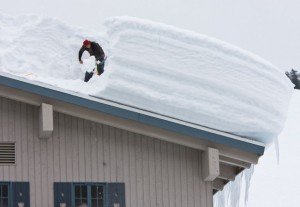
According to OSHA each year people are seriously injured or killed while performing snow removal from roof tops. Working on a roof can be dangerous anyways, add snow, ice or wind and the danger increases substantially.
OSHA investigators say falls cause the most fatalities during snow removal from roof tops. Other hazards can occur causing amputations, eye injuries, electric shock, frostbite, hyperthermia and over exertion.
In the past 10 years the 16 deaths from roof falls could have been prevented according to OSHA investigations, with proper safety techniques and training.
Removing Snow to Keep Your Roof From Collapsing
Snow removal can prevent roof collapse or is needed so construction crews can perform deck or roof repair. Methods to remove the snow include snow rakes, shovels, and snow blowers, by either standing on the roof, ladder or the ground. It is not wise to use a snow rake while standing on a ladder to remove snow from your roof; this greatly increases your risk of losing your balance and falling.
OSHA suggests using snow removal techniques that do not require you to go on the roof. Use ladders to apply de-icing materials or use snow rakes or drag lines from the ground.
If you or your roofer must go on the roof, evaluate the extra weight for you, your equipment and the extra snow and be sure to use fall safety equipment. Snow removal can be hard work; we tire more easily in cold weather increasing the potential for exhaustion, back injuries or heart attacks.
Disaster Resistant Roofs
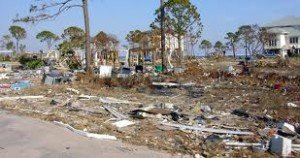
While disaster proof homes are nearly impossible, experts are saying disaster resistant homes are achievable and the insurance industry is strongly encouraging them.
Institute for Business and Home Safety president and CEO Julie Rochman said “the idea is that if we could just get the roof right, just get people to our fortified retrofitting standard. For hurricanes and high wind and hail prone areas, which is a large portion of this country, we could probably save half of all property losses in a given year”.
Building Stronger Roofs
To build stronger roofs ring shank nails can be used instead of regular smooth nails or staples for roof sheathing. The ring shank nails can double the strength of the roof making it more resistant to blowing off in strong winds.
Sealing the roof deck will keep the water out and will save on additional living expense claims. Also using screws instead of nails during a new roof install or roof repair will strengthen a roof.
The quality of construction and the differences in building codes and practices will make a big difference if you’re going to build a disaster resistant building.
Rochman gave an example of 13 fortified homes that were struck by Hurricane Ike in 2008. Three of the homes were destroyed by debris from other destroyed homes and ten of the 13 homes sustained only minimal damage.
Governor Urges to Clear Roofs
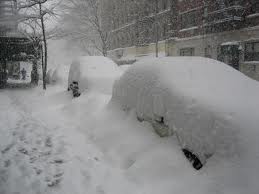
Connecticut Governor Dannel P. Malloy toured the state Monday to observe the damage done by the recent storm, calling school superintendents urging them to make sure drains are clear and flat roofs are cleared of snow.
Malloy said “Schools are important resources. Please get somebody up on the roof. At the very least, make sure that the drains are clear and working. We don’t want a tragedy to occur at one of our school buildings.”
The governor also encouraged homeowners to clear their roofs of snow. Reported roof collapses was up to 16 across Connecticut by Monday evening. Local roofers are staying busy trying to keep up with customer demands. The storm left 3 feet of snow on New England and killed seven people in Connecticut. At least 18 deaths are being blamed on the storm in the United States and Canada.
Drifts up to 10 Feet High
Malloy said “This is a historic storm; we had historic levels of snow in every one of our counties.”
Thousands of homes and businesses were without electricity and hundreds of cars were scattered on the roadways.
Heavy machinery, massive snow blowers and pay loaders are being sent from the state to help municipalities with snow removal as well as to prepare for another storm forecasted to arrive this week.
National Guard members from Pennsylvania are bringing excavators and extra equipment to remove the snow. National Guard Humvees are being used to transport sick and injured people.
Dome Roof Gym Doubles as Storm Shelter
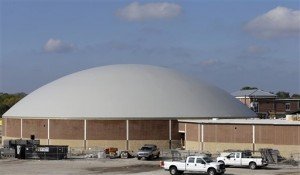 In Edna Texas a high school gymnasium was built to withstand winds up to 200 miles per hour. The windowless building with a dome shaped roof will do double duty as a storm shelter during hurricane season. The new roof has layers of concrete, insulation and rebar. Edna has a population of 5,500 and is approximately 100 miles southwest of Houston.
In Edna Texas a high school gymnasium was built to withstand winds up to 200 miles per hour. The windowless building with a dome shaped roof will do double duty as a storm shelter during hurricane season. The new roof has layers of concrete, insulation and rebar. Edna has a population of 5,500 and is approximately 100 miles southwest of Houston.
The $2.5 million building was primarily financed through the Federal Emergency Management Agency. The heavy duty building has a double layer of cinder block walls reinforced by steel bars and cement piers that are buried 30 feet into the ground.
More Domes Planned
The Edna dome is the second hurricane dome in Texas. The first dome was built near Corpus Christi in Woodsboro Texas. The domes were built to protect the residents who may not be able to leave the area, such as the elderly and the sick. Local officials and first responders will also be able to take advantage of the shelters so they will be in the immediate area to begin recovery efforts.
Local communities are paying approximately 25% of the dome costs with FEMA picking up the rest. The buildings are being built as recreation or community centers when not needed as emergency shelters.
FEMA plans to build 28 dome buildings, with shelters planned in Brownsville, Bay City, and two in Kingsville. According to Tom Vinger a spokesman for the Texas Department of Public Safety, they plan to add these structures to 11 counties in the Rio Grande Valley, Corpus Christi and along the coast from Victoria to Newton Counties.
Roof Conditions
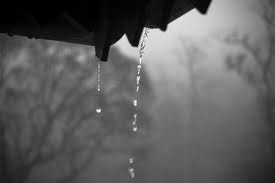
If you have a leaky roof sometimes it makes it self known by drips from the ceiling. Sometimes you can pinpoint the approximate point of leakage on the underside of the roof sheathing from the attic and then go up on the roof and determine what is causing the leak.
Most of the time roof repair is not going to be that easy, water meanders from the roof leak making it difficult to find the point of origin. Water wanders across and downward and comes through the under surface of the roof boards and then again channeling under the boards to find a place in your ceiling to drip from.
Often Looking for Leaks While it is Still Raining
Vents, chimneys and flashing can be another source of leaks. Common places for roof leaks is around flashings and vents due to roof penetrations. Visual spotting of faulty flashing can be difficult, you will have to determine the general condition such as looseness, cracks in material, folds and separations.
Check for loose shingles, and missing tabs or roofing nails. Also check for tree limbs or debris that has fallen on the rooftop. Moisture can also accumulate enough water to flow down and become a leak. Moisture can cause long term damage without ever reaching the ceiling level.
While having your roof inspected either yourself or a roofing contractor,besides checking the top side of your roof looking for damaged shingles or flashings, the inspection should also include a close look at the underside of the roof checking for discoloration and water marks.
Moisture is a Roof’s Nemesis

Wood roofing materials will last for many years with the absence of moisture. Measures are taken to control moisture in the wood building materials of your home to help it last longer.
Ventilation helps control moisture by allowing the wood to dry out quickly. When wood materials to become moist the wood gets larger with swelling and contracting smaller when dry. The action of expansion and contracting can case cracks in materials. Caulking in joints or openings will keep the wood material flexible and bend with the movements.
Excess Moisture can Cause Serious Damage
Moisture can accumulate in spaces of exterior walls and attic areas. Trapped moisture can reduce the thermal resistance value of insulation materials and can cause blistering and peeling of paint. Brown lines and discoloration on boards can be caused by spreading moisture.
When the underlying felt of asphalt roof coverings become wet the roof can buckle in built up tar and gravel roofs. Often wood surfaces appear to be dry, by scratching across the grain with a screwdriver or coin. If scratching produces indention marks and no wood fibers break loose, the wood is probably wet. If however slivers of wood break loose then the wood is probably dry.
Keeping your home dry and controlling the moisture is a key concern for most homeowners. A leaky roof will allow rain and snow to come into your home, you will either need to perform roof repair or replace your roof. Moisture is also generated in your home from cooking, bathing, washing dishes and clothes.
A vapor barrier on the inside over the wall and ceiling insulation will keep the wood dry. Adequate ventilation for attic and eave areas is a good measure to control moisture in your home.
Two Ohio Roofers Hit by Lightening

2 roofers were hit by lightning in Dayton Ohio on Saturday August 4th. They were up on the two-story un-shingled roof trying to cover it with tarps when the storm rolled through. The roofing crew had been up on the roof at 3101 East Fourth Street most of the day doing roof repair. The vacant house is undergoing renovations.
It is unclear if the men were hit or the roof they were standing on was, but witnesses say they saw lightening “traveling through their body”. One of the roofers fell off the two-story roof and sustained serious injuries while the other roofer was able to get back inside the attic of the vacant home.
Fire Captain Said Don’t Worry about Water Damage, Protect Yourself
Co-workers tried to assist the two men but were unable to get the one man off the roof. Both men were taken to Miami Valley Hospital by ambulance. Police said they are lucky to be alive and firefighters said both men will survive.
A small fire was also started on the roof by the lightning strike. Dayton Fire Captain Bob Cockayne said the fire was very minor and put out quickly.
Check Your Roof before the Summer Storms

According to Bud Taylor from the facilities management at University of Arizona, preventive measures can go a long way into saving your roof if a serious storm hits your home. “In 30 years on rooftops in Arizona, the best way I’ve found to take care of monsoon season is preventive maintenance. You can’t wait until after the fact.”
Taylor, three full time and one part time roofer walk the 3.5 million square feet of campus rooftops, if there is anything that needs to be fixed, they take care of it immediately.
Be Safe on Your Roof
He suggested homeowners check their roofs for cracks, standing water, missing shingles and any other signs of damage. Also check the rain gutters to make sure they are not damaged or blocked. Taylor also suggested wearing a harness or other safety equipment, and if you are in doubt hire a professional.
You can check for leaks inside your home also, take your flashlight up into your attic to check for leaks or other problems. Look at the ceiling in each room, checking for mold or stains.
If you do find roof problems, your options are you can patch or replace your roof. You may be comfortable making simple patches and replacing a shingle or two, but you should probably consider hiring a professional if more work is needed.
Along with the summer storms come scam artists. Be wary of door to door roofing companies that come to your home uninvited. And never give any money up front. If the deal sounds too good to be true, it probably is.
The best course of action is to call 3 reputable roofing companies in your area to come out and give you a written estimate, also check the Better Business Bureau for any issues regarding the roofing companies you are considering hiring.
Preparing Your Roof For The Seasons
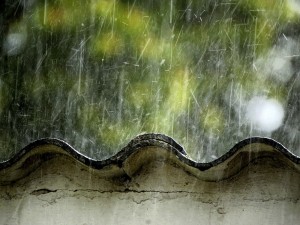 There is much to think about around the house as the seasons transition from winter into spring and then into summer. Having been neglected for the past few months, your roof is mostly likely in need of some TLC. Even if the roof is in good condition, there are still a few things you should do to ensure it is ready for the upcoming weather.
There is much to think about around the house as the seasons transition from winter into spring and then into summer. Having been neglected for the past few months, your roof is mostly likely in need of some TLC. Even if the roof is in good condition, there are still a few things you should do to ensure it is ready for the upcoming weather.
Spring Rains
The spring season is known for its rainy months, as well as severe weather. While general rainfall only poses a small risk to the roof if it is damaged, severe storms that have hail and high winds are quite another challenge. Roof repair is most common in the spring and summer months as many homeowners neglect their roofs during the winter months and fail to inspect the roof as the weather changes. There could be many minor roof problems that lead to serious damage when rain and wind hits, leading to more expensive repairs. While there isn’t much you can do to protect your home from hail, high wind or rain, you can ensure that your roof materials are in good condition and there aren’t any leaks or weak spots in the roof.
Summer Heat
The high temperatures associated with the summer months bring unique challenges to your roof. Not only must the roof resist the heat, but the damage from the sun’s rays can cause a significant increase in the heat inside the home. Some roof materials are better at reflecting heat and keeping the interior of the home cool better than others. If you haven’t considered upgrading your roof before, this summer may be the time to look into installing a white roof coating or other energy efficient product. If you live in a region with ample sunshine, installing solar roof panels is a great way turn the summer sun into cost saving energy you can use in the home.






